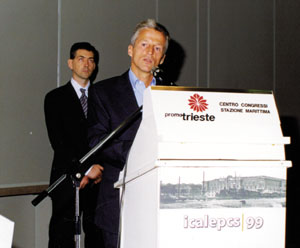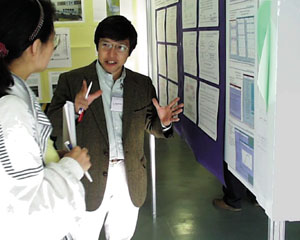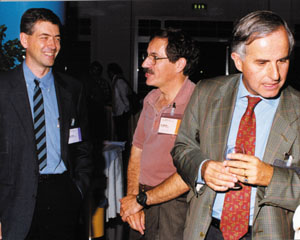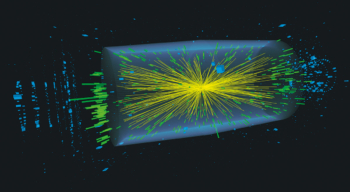Control by computer was once the domain of major facilities like particle accelerators. With these methods now being used across the board, a recent international conference on control systems for physics, held in Trieste, drew a large audience.

The changing face of physics and physics research is underlined by the increasing use of and emphasis on sophisticated control systems. Once dominated by systems for big particle accelerators, control systems are now widely used in other major facilities, and increasingly in large experiments.
This was demonstrated at the recent International Conference on Accelerator and Large Experimental Physics Control Systems (ICALEPCS), the scientific and technical programme of which covered controls for, among others, particle accelerators, detectors, telescopes, nuclear fusion devices and nuclear reactors.
ICALEPCS’99 saw an increased number of contributions from the plasma physics and astronomical community and also, although to a lesser extent, from the particle detector community. Philippe Charpentier of CERN presented a memorable talk entitled “The evolution of the DELPHI experiment control system – how to survive 10 years of running”.
ICALEPCS looked at all aspects – hardware and software – of experimental physics control systems, but concentrated on how controls can contribute to the success of a major experiment. With this objective in mind, different technology and engineering issues were covered. State-of-the-art software and hardware technologies were reviewed in terms of the possibilities that they offer for dealing with systems of increasing complexity and sophistication within restricted budgets and human resources.
Software
In the software domain, several applications that were described are based on Windows NT using the Common Object Request Broker Architecture (CORBA) as a distributed programming model. Examples are A Goetz (ESRF, France) with “Tango – an object oriented control system based on CORBA”; and C Scafuri (Sincrotrone Trieste, Italy) with “The ELETTRA object-oriented framework for high-level software development”, as a distributed programming model, using Java as a programming language.
Noteworthy is the growth of Windows 98/NT, followed closely by Linux. Both are competing with the more traditional UNIX platforms. Increased geographical distribution of systems as well as requirements relating to remote observation and monitoring lead naturally to the application of the Web and related technologies (J Farthing, JET, UK – “Technical preparations for remote participation at JET”).
The crucial role played by well integrated centralized data repositories was also emphasized by H Shoaee (SLAC, Stanford) – “The role of a central database for configuration management”. Indeed, controls are no longer stand alone systems but rather part of a unity that ties physics to other areas, both technical and administrative, in a Computer Integrated Manufacturing environment.
Although the Experimental Physics and Industrial Control System (EPICS) is still rather popular as a framework and set of tools for developing control system software, both in the US (K White – “The evolution of Jefferson Lab’s control system”) and in some non-US labs, commercial Supervisory Controls and Data Acquisition (SCADA) systems are now penetrating the experimental physics “market” as well (A Daneels, CERN – “What is SCADA?”).
SCADA systems prove to be effective and efficient in controlling infrastructure systems such as vacuum, cryogenics, cooling, ventilation and personnel access, and in controlling experimental physics processes such as some small to medium-sized particle detectors.
In the wake of SCADA, technologies such as OLE for Process Controls (OPC) and SoftPLC are becoming more popular.
Hardware
The hardware domain makes increasing use of commercial Programmable Logic Controllers (PLC) connected to devices via fieldbuses, and of PCI (Peripheral Component Interconnect) and its related standards.
With restricted resources, and individual in-house development minimized in favour of buying industrial systems, the task of experimental physics control specialists is steadily moving towards the integration of these industrial products into an overall comprehensive and consistent control system.
Networks are being re-engineered using 100 Mbit/s Ethernet with GigaEthernet backbones, while the Asynchronous Transfer Mode (ATM) is also considered to be candidate technology for the long distance communication of time-critical accelerator data.
Of particular importance are timing systems (T Korhonen, PSI, Switzerland – “Review of accelerator timing systems”). Telescopes as well as tokamaks and accelerators require highly stable, highly precise and highly flexible timing systems, both for event timing and counter-based systems.
The increasing complexity and sophistication of physics processes leads to the introduction of ever-more complex feedback systems, often themselves relying on measurements that need high data rates. Such high-performance measurements may require sampling rates as high as hundreds of megahertz and state-of-the-art Digital Signal Processors (DSP) (J Lister, CRPP-EPFEL, Switzerland – “The control of modern tokamaks”; J Safranek, SLAC – “Orbit control at synchrotron light sources”; and T Shea, Brookhaven – “Bunch-by-bunch instability feedback systems”).
In particular, new developments in the field of accelerator power supplies are taking advantage of the available digital technology by the use of embedded DSP controllers; the digital generation of high-stability, high-precision reference signals; and real-time algorithms for regulation (J Carwardine and F Lenkszus, Argonne – “Trends in the use of digital technology for control and regulation of power supplies”).
Engineering and management
The frequently unappreciated engineering and management aspects of control systems were also highlighted. The weight of maintenance and adaptation costs in software projects were discussed.
In the context of increasingly elaborate systems and reduced resources, and considering the progress demonstrated by industry in keeping proper control of the lifecycle of software development, project management and engineering have shown their worth in today’s physics world as well. Particular attention was paid to requirements engineering, and emphasis was given to sharing experiences and techniques in these fields. Applications of solutions from the industrial world were also presented and discussed.
News content came from status reports from a variety of control and data acquisition projects of new experimental physics facilities. Among them were the Swiss Light Source (SLS), which is being built at the Paul Scherrer Institute in Villigen, Switzerland (S Hunt, PSI – “Control and data acquisition system of the Swiss Light Source”), and the Spallation Neutron Source (SNS), which is to be built in Oak Ridge, US (D Gurd, Los Alamos – “Plans for a collaboratively developed distributed control system for the Spallation Neutron Source”). Gianni Raffi from the European Southern Observatory summarized the meeting.

Added attractions
As well as the conference, two preconference workshops covered EPICS (Experimental Physics Industrial Control System) and SOSH (Software Sharing), which were organized by M Clausen of DESY and W A Watson of Jefferson Lab, respectively.
During the conference, a round table discussion, “Prospective directions in controls in geographically distributed collaborations”, chaired by W Humphrey (SLAC) and involving H Burckhart (CERN), R Claus (SLAC), J Farthing (JET), D Gurd (Los Alamos) and G Raffi (ESO), focused on the management of projects developed by distributed teams and on the experience with the available technologies for long-distance interaction.
Four tutorials covered special topics: “Cases for requirements capture and tracing” (G Chiozzi, ESO); “Network technology” (G Montessoro, Udine); “Introduction to JAVA” (J P Forestier, OSYX, France); and “Introduction to OPC” (OLE for Process Control) (F Iwanitz, Softing, Germany).

ICALEPCS’99, the seventh biennial conference, was held in Trieste on 4-8 October 1999, hosted by Sincrotrone Trieste. It took place at the “Stazione Marittima”, which has recently been restored as the city’s congress centre.
The meeting was organized by Sincrotrone Trieste in conjunction with the European Physical Society’s (EPS) Interdivisional Group on Experimental Physics Control Systems and the Istituto Nazionale di Fisica Nucleare. The International Scientific Advisory Committee was chaired by D Bulfone of Sincrotrone Trieste and A Daneels of CERN.

The meeting brought together some 400 control specialists from 32 different countries, covering Africa, the US, Asia and Europe, and representing 116 organizations. The proceedings are available at “http://www.elettra.trieste.it/ICALEPCS99/”. An industrial programme included an exhibition and seminars.
During the conference the EPS Experimental Physics Control Systems prize was awarded for the first time. It went to T Wijnands of CERN for an advanced plasma control system for TORE SUPRA.





